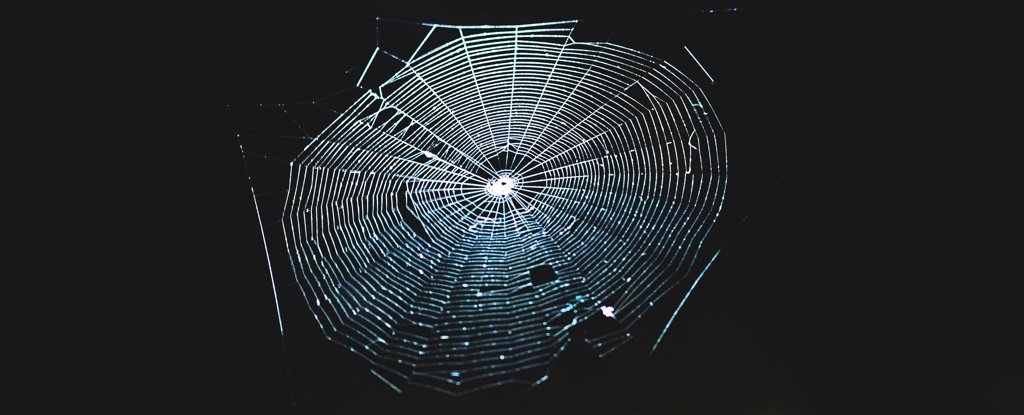Spiders depend quite noticeably on contact to sense the planet all around them. Their bodies and legs are protected in little hairs and slits that can distinguish amongst various forms of vibrations.
Prey blundering into a world-wide-web helps make a incredibly various vibrational clamor from a different spider coming a-wooing, or the stirring of a breeze, for case in point. Every strand of a world-wide-web provides a various tone.
A handful of years in the past, scientists translated the three-dimensional framework of a spider’s internet into new music, working with artist Tomás Saraceno to make an interactive musical instrument, titled Spider’s Canvas.
The group later refined and constructed on that past do the job, incorporating an interactive digital fact element to let people to enter and interact with the internet.
This research, the staff claims, will not only assist them far better realize the three-dimensional architecture of a spider’s web, but may well even support us study the vibrational language of spiders.
“The spider lives in an atmosphere of vibrating strings,” engineer Markus Buehler of MIT discussed in 2021. “They do not see very perfectly, so they perception their environment via vibrations, which have distinct frequencies.”
When you think of a spider’s world wide web, you most most likely believe of the web of an orb weaver: flat, spherical, with radial spokes around which the spider constructs a spiral net. Most spiderwebs, nevertheless, are not of this form, but created in 3 dimensions, like sheet webs, tangle webs, and funnel webs, for instance.
To check out the composition of these sorts of webs, the group housed a tropical tent-internet spider (Cyrtophora citricola) in a rectangular enclosure, and waited for it to fill the room with a a few-dimensional world wide web. Then they utilized a sheet laser to illuminate and develop high-definition images of 2D cross-sections of the internet.
https://www.youtube.com/observe?v=QsoCCRpSp-Q
A specially developed algorithm then pieced together the 3D architecture of the world wide web from these 2D cross sections. To turn this into tunes, unique sound frequencies were allocated to distinctive strands. The notes as a result produced were being played in patterns based on the web’s construction.
They also scanned a web while it was becoming spun, translating every single step of the course of action into new music. This means that the notes transform as the structure of the net improvements, and the listener can hear the system of the web’s building.
Having a report of the stage-by-step process usually means we can also much better fully grasp how spiders establish a 3D net without the need of assist buildings – a ability that could be used for 3D printing, for illustration.
https://www.youtube.com/enjoy?v=HL_MHD93wFc
Spider’s Canvas authorized audiences to hear the spider audio, but the virtual truth, in which customers can enter and enjoy strands of the website themselves, provides a complete new layer of experience, the scientists stated.
“The digital truth setting is genuinely intriguing mainly because your ears are likely to decide up structural capabilities that you may possibly see but not quickly figure out,” Buehler spelled out.
“By listening to it and observing it at the very same time, you can seriously get started to realize the atmosphere the spider life in.”
This VR environment, with realistic world-wide-web physics, enables researchers to have an understanding of what occurs when they mess with parts of the web, as well. Extend a strand, and its tone alterations. Crack one, and see how that affects the other strands all over it.
This, far too, can assistance us fully grasp the architecture of a spider’s net, and why they are constructed the way they are.
Probably most fascinatingly, the get the job done enabled the workforce to develop an algorithm to discover the sorts of vibrations of a spider’s net, translating them into “trapped prey”, or “web below building”, or “yet another spider has arrived with amorous intent”.
This, the workforce explained, is groundwork for the enhancement of learning to converse spider – at the very least, tropical tent-net spider.
“Now we are striving to make synthetic signals to in essence communicate the language of the spider,” Buehler stated.
“If we expose them to particular designs of rhythms or vibrations, can we affect what they do, and can we start out to talk with them? These are actually exciting concepts.”
The team’s previous analysis was printed in 2018 in the Journal of the Royal Culture Interface.
An before edition of this posting was released in April 2021.







More Stories
YouTube Songs tends to make its way to the Garmin app retailer
TikTok strikes deal with Adobe to bring its Commercial Music Library to AI content creation app Adobe Express
YouTube Music’s no cost strategy is about to get a large amount less practical in Canada